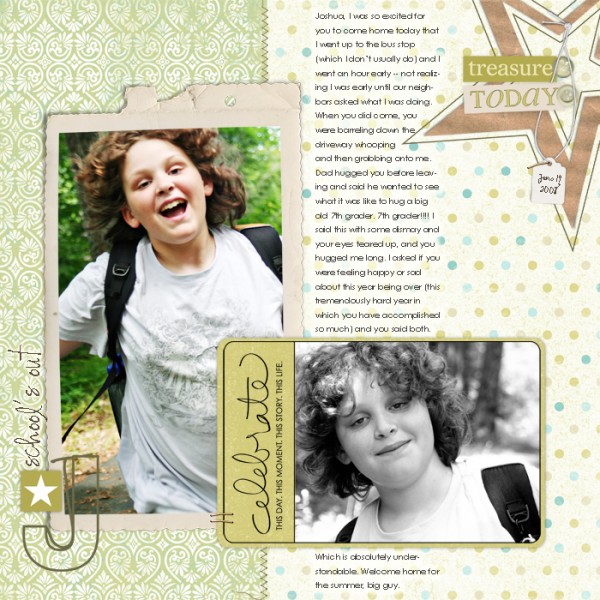Writing story journaling is different from writing journaling for scrapbook pages that address a subject like “Piano playing in my life,” “My Favorite Place,” or “On Vacation in DC.”
Scrapbooking a story means telling about a particular event (which may take place in few minutes or over a longer period of time). In this telling there will be characters (you included) and these characters will be “on-stage” doing and speaking as something of note happens.
the shape of a story
Aristotle said it first, and storytellers have been paying attention ever since A story needs a beginning, a middle, and an end.
beginning: Figuring out where to start your story can often be the toughest challenge. The best beginnings start with something that is:
1) interesting (like an event, or decision, or information) AND
2) crucial to the story as a whole.
I often find the best way to start is to just write the whole piece and then go back and lop off the first few paragraphs which ended up being warm-up practice.
middle: This is the part where you take your audience from the beginning to the end, filling in the details — some crucial, some just entertaining — while sustaining interest and maybe even adding some tension.
end: In the end, a story needs a point. This is where you wrap everything up and, most importantly, this wrapping up should be connected to how your story started.
You can see this structure in “So You Know.” — I’ve inserted “BEGINNING,” “MIDDLE,” and “END” into the journaling in the caption for the layout.

BEGINNING: The bundled-up and home-from-school-sick photo came BEFORE the photos of you jumping into a cold May river. MIDDLE: You had a cold and just looked terrible and I’m a soft touch. During the day, I had you on the deck all covered up and with a hat reading “The Phantom Tollbooth” and playing with puzzles. Then life got busy. Daddy had his honors students over for dinner & I was in & out with appointments for Joshua & you were loving the action. END: Just before I left for the campout meeting, I looked down at the river to take a photo with my zoom lens. . . Joshua’s hair looked really flat. And . . . wet. I called down, “Did you guys go in the water?” And that’s when Daddy said, “I thought you left!” That’s cool, baby, but you’re going to school tomorrow! 05/13/08.
Steps for writing a slice-of-life story
- Use your photos as the story trigger–to remind you of something that happened.
- Use your photos as a trigger for remembering specific details. What did you (and the others in your story) see, smell, hear, taste, feel? Just start writing without overthinking it. You can go back and edit later.
- Include your own voice, thoughts, viewpoint both at the time of the story and/or after. Think about the tone you’d like to set and then decide whether you’re going to use your “concerned-daughter” or “smart-alecky sister” voice. Think: is this a story suited to humor or earnest recounts?
- Make sure the story has a clear beginning, middle, end.
- Use a mix of narrative & scene.
- Finish with insight, meaning, import, or at least a final reflection. What does the story tell about you or your subject?
“Celebrate School’s Out” uses a mix of narrative and scene and ends meaningful conversation and brief commentary on what was said.

Joshua, I was so excited for you to come home today that I went up to the bus stop (which I don’t usually do) and I went an hour early -- not realizing I was early until our neighbors asked what I was doing. When you did come, you were barreling down the driveway whooping and then grabbing onto me. Dad hugged you before leaving and said he wanted to see what it was like to hug a big old 7th grader. 7th grader!!!! I said this with some dismay and your eyes teared up, and you hugged me long. I asked if you were feeling happy or sad about this year being over (this tremendously hard year in which you have accomplished so much) and you said both.Which is absolutely understandable. Welcome home for the summer, big guy.
[lovejournaling]


